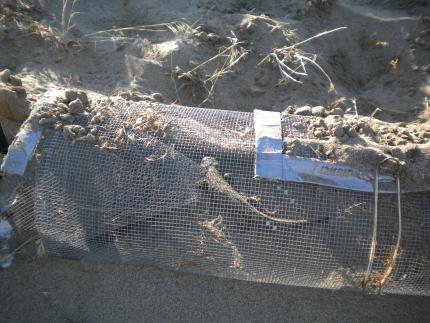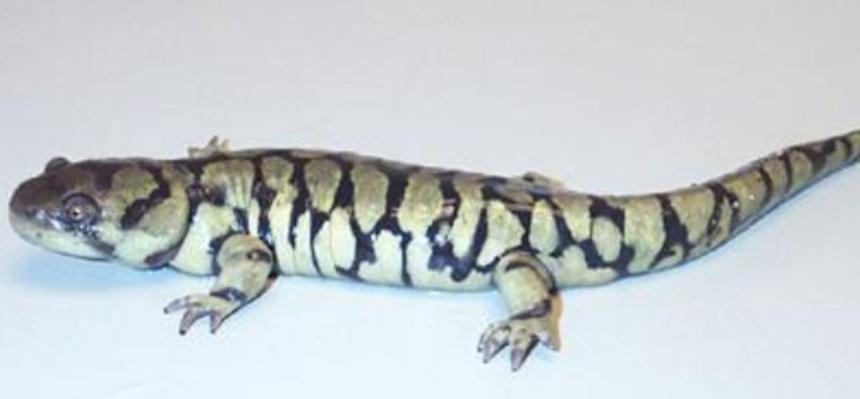Moderate-
High
This salamander is considered rare or uncommon in Washington; it is vulnerable due to its small number of populations, a range that is restricted to a region that has been heavily altered, and a lack of information about this species.
A main concern is the drastic decline in stream flows and water body volume in much of Lincoln County and adjacent portions of Grant and Adams counties caused by water withdrawal for agriculture. Larger remaining water bodies may not be suitable habitat because they may contain introduced predatory fish that eat larval salamanders.
Description and Range
Physical description
The tiger salamander is a large, stocky, blotched salamander (6.4 inches snout to vent length). It has a rounded blunt snout, small protruding eyes, distinct costal grooves and a laterally compressed tail.
Metamorphosed (transformed) tiger salamanders have green or yellow blotches over the entire surface of the body; there are paired tubercles on the underside of the feet and, a fourth toe that is not exceptionally long.
For identification purposes of eggs and larvae, it is important to note that the long-toed salamander commonly occurs with the tiger salamander. In Klickitat County, the rough-skinned newt also occurs with the tiger salamander.
Larvae
Larvae are pond-type. The gills are large and the filaments are similar in length along the entire stalk.
The larvae of the tiger salamander and long-toed salamander are similar, however, tiger the hatchlings do not have balancers, and larvae have large gills with similarly sized filaments from top to bottom.
Rough-skinned newt larvae have a small, narrow head with eyes on the lateral edges. There is a dark horizontal stripe through the eye, a line of white dots on the sides, and a pink belly. Larvae of the tiger salamander and long-toed salamander are similar, however, tiger salamander larvae are light colored.
Neotenes
Gilled adults (neotenes) are large (to about 7 inches snout to vent length) with a wide head, small eyes and wide gill stalks.
Eggs
Eggs are small (ovum and gelatinous envelope that is less than 0.4 inches) and laid singly on plant stalks and twigs.
Eggs of the tiger salamander and long-toed salamander are similar, however, tiger salamander eggs are smaller (ovum and gelatinous envelope less than 0.4 inches) with a light colored ovum. Rough-skinned newt eggs are usually hidden within aquatic vegetation.
For more details about tiger salamander, see the Washington Herp Atlas.
Ecology and life history
Occurrence of tiger salamanders is primarily in arid areas that support shrubsteppe vegetation. They tolerate some habitat disturbance and alteration. In the Colville area, they occupy lower elevations in dry habitat types characterized by ponderosa pine/ Douglas fir forest.
Tiger salamanders are habitat generalist, but do require fishless water bodies for breeding. Soil types suitable for burrowing are also important because they are active burrowers. They also use mammal burrows. Metamorphosed forms spend most of their lives in the subterranean environment, and surface activity is nocturnal.
Breeding takes place primarily in perennial ponds, although seasonal water bodies are also used. Gilled adults occur only in perennial ponds, and their ability to metamorphose is lost with increasing age. Mass mortality events of the larvae can occur if ponds dry.
Tiger salamanders migrate to breeding ponds in the spring, and eggs are laid in mid-March to early April in the Columbia Basin. Whether or not the larval salamanders metamorphose depends on a combination of genetic and environmental factors.
Larvae are capable of transforming in the fall of their first year, but in permanent water bodies they delay for two or more years. They can also become sexually mature in the larval form. The gilled adults (or neotenes) can grow to larges sizes than the metamorphosed forms.
Ponds often contain many different size classes of larvae. All forms are gape-limited, opportunistic predators, with invertebrates making up the majority of their diet. Large terrestrial adults may also take small vertebrates.
Tiger salamanders are important predators in ponds and can influence both the vertebrate and invertebrate communities.
They are long-lived (16 to 25 years), although the lifespan of wild individuals is likely shorter.
Geographic range
Tiger salamanders are the most widely distributed of all North American salamanders. In Washington, they occur primarily within the Columbia Plateau Ecoregion. Occurrences in the Okanogan and Eastern Cascades Ecoregions are limited to the steppe and ponderosa pine vegetation zones.
An isolated record for Klickitat County is documented through a specimen collected in the 1930s, but no populations are currently known in this area.
This map from the Washington Herp Atlas illustrates the distribution of tiger salamander in Washington based on records in the WDFW database as of 2016. If you see this species in areas that are not indicated on the map or have more recent observations (less than 10 years), please share your observation using the WDFW wildlife reporting form.
For maps of range-wide distribution and conservation status of this species, check out NatureServe Explorer and the International Union for the Conservation of Nature Red List.
Climate vulnerability
Sensitivity to climate change
High
Little information exists regarding sensitivity of the tiger salamander to climate change, particularly in Washington. This species likely exhibits sensitivity to warmer and drier conditions that reduce aquatic breeding habitat, lead to desiccation, and/or result in an inability to move. Warmer temperatures and a decrease in total annual precipitation (including snow), as well as an increase in drought, has led to wetland desiccation and significant population declines in Yellowstone National Park. Timing of reproduction may also be affected by increasing temperatures. Tiger salamanders, which are only weakly secondary burrowers, are largely dependent on primary burrowers for overwintering sites, aestivation sites, and temporary refuge sites during their seasonal activities. Hence, if key primary burrowers, such as badger, several ground squirrel taxa (some listed), kangaroo rats, or pocket mice are sensitive to climate change in a manner that they become locally extirpated, their disappearance will likely to negatively impact tiger salamanders.
Exposure to climate change
Moderate
- Increased temperatures
- Changes in precipitation and/or reduced snowpack
- Drought
Regulations
Licenses and permits
Be advised that collection of this species is only permitted under a WDFW Scientific Collection Permit for research and educational activities.
Conservation

Conservation Threats and Actions Needed
- Resource information collection needs
- Threat: Lack of information on status and distribution.
- Action Needed: Continue research, surveys and monitoring to understand species distribution and status.
- Fish and wildlife habitat loss and degradation
- Threat: Loss and degradation of suitable shrubsteppe habitat that this species relies upon in Washington.
- Action Needed: Protect native shrubsteppe habitat from further degradation or conversion to agriculture.
- Agriculture and aquaculture side effects
- Threat: Drying of water bodies and streams due to withdrawals of irrigation water at a rate faster than aquifers can naturally replenish. Surface water declines in the Lincoln County region since the 1980s are likely related to ground water withdrawals and declines in the Columbia River aquifer.
- Action Needed: Protect tiger salamander habitat by preventing the drying of wetlands, ponds, lakes and streams. Protect the aquatic habitat that remains.
- Invasive and other problematic species
- Threat: Stocking of non-native predatory fish in tiger salamander habitat. Tiger salamanders avoid water bodies with fish.
- Action Needed: Identify important areas for tiger salamanders and prohibit fish stocking in occupied water bodies.
- Climate change and severe weather
- Threat: Drying of water bodies and streams. Loss of aquatic habitat is already an issue in parts of the Columbia Basin (see previous entry). Periods of drought would exacerbate the situation.
- Action Needed: Maintain robust populations and suitable aquatic habitats across the range.
See Climate vulnerability section for more information about the threats posed by climate change to this species.
Resources
References
Corkran, C. C. and C. Thoms. 1996. Amphibians of Oregon, Washington and British Columbia. Lone Pine, Redmond, Washington. 175 pp.
Jones, L. L. C, W. P. Leonard and D. H. Olson (Eds.). 2005. Amphibians of the Pacific Northwest. Seattle Audubon Society. 227pp.
Leonard, W. P., H. A. Brown, L. L. C. Jones, K. R. McAllister and R. M. Storm. 1993. Amphibians of Washington and Oregon. Seattle Audubon Society The Trailside Series, Seattle, Washington. 169 pp.
Nussbaum, R. A., E. D. Brodie, Jr., and R.M. Storm. 1983. Amphibians and Reptiles of the Pacific Northwest. University of Idaho Press, Moscow, Idaho. 332 pp.
Petranka, J. W. 1998. Salamanders of the United States and Canada. Smithsonian Institutional Press, Washington. 587pp.
Stebbins, R. C. 1985. A Field Guide to Western Reptiles and Amphibians, 2nd Edition. The Peterson Field Guide Series. Houghton Mifflin Company, Boston. 336 pp.
Personal communications
Liana Aker, Washington Department of Fish and Wildlife, Vancouver, Washington.
WDFW publications
- Hallock, L. A. and McAllister, K. R. 2005. Tiger Salamander. Washington Herp Atlas. 2009. A cooperative effort of Washington Natural Heritage Program, Washington Department of Fish and Wildlife, U.S.D.I. Bureau of Land Management, and U.S. Forest Service. Map products updated March 2017. Provisional PDF version of the website (2005-2019) created July 2019. 250 pp.
WDFW educational resources
- Wild Washington Lesson Plan – Herps in Washington - Elementary school students are introduced to the cold-blooded world of reptiles and amphibians, also known as herps.
- Family Education – Amphibians and Reptiles - Slither, hop, or crawl on over to learn about herpetofauna!


